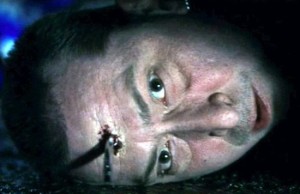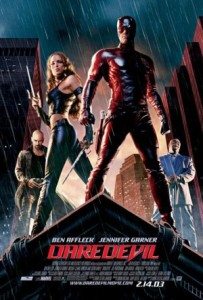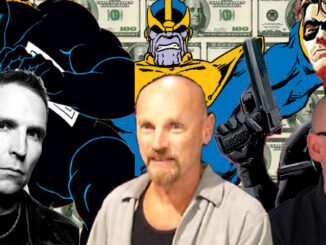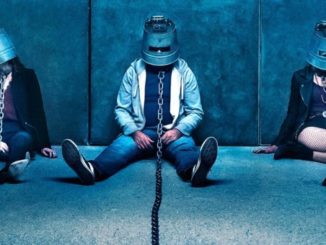In a multi-part series, Comic Book Film Editor William Gatevackes will be tracing the history of comic book movies from the earliest days of the film serials to today’s big blockbusters and beyond. Along with the history lesson, Bill will be covering some of the most prominent comic book films over the years and why they were so special. Today, one of Marvel’s second tier characters gets the movie treatment–Daredevil.
 Daredevil was the red-headed stepchild of the Silver Age Marvel Comics. He was one of the last concepts introduced in the companies resurgence, and the lack of effort showed.
Daredevil was the red-headed stepchild of the Silver Age Marvel Comics. He was one of the last concepts introduced in the companies resurgence, and the lack of effort showed.
While the character had a good hook (Matt Murdock was a lawyer blinded by radioactive waste as a child who gained radar sense in the accident, and he used that power to fight crime), he came off as a pale imitator of the other urban vigilantes at the time. He was a superpowered Batman (complete with the Joker-like Jester and Penguin-like Owl as adversaries), or a boring version of Marvel’s own Spider-Man.
Marvel struggled for over a decade to try and create a unique identity for the character. He got a costume change seven issues into his run. He gained a second alternate identity for a time (Mike Murdock, supposedly Matt’s flashy, hipster brother, but really also Matt in disguise). He moved from New York to San Francisco and back again. He got a sidekick/slash love interest in Black Widow for a brief period. But nothing seems to stick. By the late 70s, the title had gone to a bi-weekly schedule, the last resort Marvel used before it cancelled a title.
Enter Roger McKenzie and Frank Miller. McKenzie presented Daredevil in a darker, noir style of stories, which the character fit immediately. However, artist Miller didn’t think McKenzie was taking the character too far into the noir world, and threatened to leave the book. Instead, McKenzie was fired and Miller was given the task of writing and drawing the feature.
This turned out to be the best thing to ever happen to Daredevil. Miller plunged the character deeply into a grim and gritty world of gangsters and ninjas. Death was always an option and betrayal was always near. Miller’s Daredevil was a haunted, damaged hero, one who was almost too willing to stoop to the level of the killers he faced.

Miller introduced an old flame of Matt’s who became the assassin Elektra. He took old DD villain Bullseye and turned him into a raving psychopath with a particular obsession with our hero. And he also made Spider-Man villain Kingpin a feared crime boss more in line with real world crime figures. Miller eventually put these characters on a collision course, one that ended with the death of Elektra at the hands of Bullseye, as ordered by Kingpin.
Miller’s Daredevil was a shock to the system, not only to the character and the title, but also to the larger world of comics as a whole. Miller was at the for front of the artist/writer movement at Marvel, his reboot sharing the shelves with John Byrne’s Fantastic Four and Walt Simonson’s Thor reboot as well. But he was also part of the larger comic book deconstructionism that Alan Moore and others were working on at other companies.
Miller’s work on Daredevil influenced the character for decades to come. While the character did have some rough periods (namely, the 1990s), Miller set the stage for writers such as Denny O’Neil, Ann Nocenti, Kevin Smith (yes, that Kevin Smith), Brian Michael Bendis, and Ed Brubaker to create excellent Daredevil stories. Even Mark Waid’s current awesome, kinder and gentler take on Daredevil would not be possible without Miller’s influence. And Miller’s influence was also heavily felt in the 2003 film adaptation.
There had been several attempts to bring Daredevil to cinematic life. The earliest was in the mid-70s when Angela Bowie was shopping around a Daredevil/Black Widow TV project. The character also had a back door pilot with The Trial of the Incredible Hulk. But the character’s trek to the big screen began in earnest in 1997.
 That’s when 20th Century Fox first optioned the rights to the character, with Chris Columbus in line to write and direct the feature. This first time didn’t pan out and the rights reverted to Marvel. Disney made a play at getting the rights, but the project was instead set up at Columbia Pictures, with Mark Steven Johnson brought on to rewrite the script. Eventually, they passed and the rights moved on to New Regency in 2000 with Fox now on board to distribute. Johnson was also named director of the film.
That’s when 20th Century Fox first optioned the rights to the character, with Chris Columbus in line to write and direct the feature. This first time didn’t pan out and the rights reverted to Marvel. Disney made a play at getting the rights, but the project was instead set up at Columbia Pictures, with Mark Steven Johnson brought on to rewrite the script. Eventually, they passed and the rights moved on to New Regency in 2000 with Fox now on board to distribute. Johnson was also named director of the film.
Casting began on the film. Guy Pierce was approached to play Matt Murdock, but he passed because comic book stuff really wasn’t “his cup of tea.” (I guess he got used to the taste of that kind of tea, because a decade later, he would go on to be the main bad guy in Iron Man 3). Matt Damon also got the call, but passed over issues with the script and director. Eventually, the role went to Damon’s friend, and fan of the Daredevil comic book, Ben Affleck.
Colin Farrell, once also up for the role of Daredevil, took the role or Bullseye. Jennifer Garner beat out actresses ranging from Selma Hayek to Jessica Alba for the role of Elektra. And for the role of the fat, Caucasian Kingpin, they chose the muscular African-American Michael Clarke Duncan. That might seem to be a fairly egregious bit of miscasting, but Duncan did better in his role than the other two did in theirs. Farrell’s overacting got a bit too much sometimes, and Garner was as believable as a Greek shipping heiress as Brad Pitt would be as the ugliest man alive.
But while the film had its share of miscues, and is a constant target of scorn and derision from comic book fans, I liked it. Well, it had me on its side after it gave Kevin Smith a cameo as a mortician called Jack Kirby, but I thought it was an okay presentation of the material. I really liked the way they added elements of the comic book series into the film. The dialogue for the Elektra/Bullseye fight was taken almost word for word from the Frank Miller dialogue in the comics when Bullseye killed Elektra.
While I liked the film, I didn’t care too much for what came out of it. With grosses in excess of $179 million, Fox wanted to capitalize on Daredevil’s success. They did so by giving us Rob Bowman’s Elektra. They really shouldn’t have.
 I can’t really garner much animosity for the film. My only remembrances of watching it was being bored by it. But this film failed because it didn’t know what it wanted to be. The script by Zak Pen, Stuart Zicherman and Raven Metzner was at war with itself. Was it a superhero movie setting Elektra against superpowered villains? Was it a martial arts tale? Was it a thriller? Was a Hallmark-lite version of female self-discovery? Whatever it was going for, it didn’t do it well.
I can’t really garner much animosity for the film. My only remembrances of watching it was being bored by it. But this film failed because it didn’t know what it wanted to be. The script by Zak Pen, Stuart Zicherman and Raven Metzner was at war with itself. Was it a superhero movie setting Elektra against superpowered villains? Was it a martial arts tale? Was it a thriller? Was a Hallmark-lite version of female self-discovery? Whatever it was going for, it didn’t do it well.
Elektra took in more than its budget, but was still considered a disappointment. That combined with a growing disdain for Daredevil made any sequel to that film impossible. Eventually, talks turned to a reboot with David Slade at the helm. When he left the project, there was only a limited time left on Fox’s option. A last minute of getting a reboot up and running by Joe Carnahan fell through, and the rights reverted back to Marvel. But Carnahan did put together one great sizzle reel.
Marvel has decided the future of DD did not lie on movie screens, but on your computer. It is developing Daredevil for a series on Netflix.
Next up, the noble failure that was Ang Lee’s Hulk.





HISTORY OF THE COMIC BOOK FILM: Giving The Devil His Due http://t.co/qftlW3gBV3